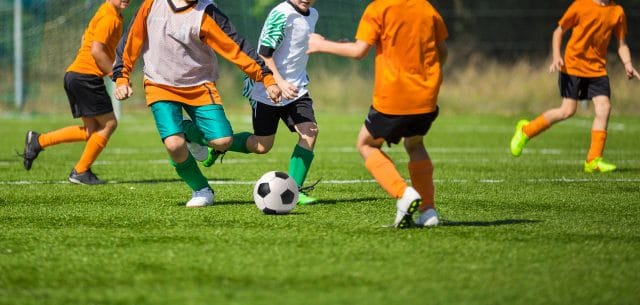An extract from Soccer Training Blueprints by James Jordan.
His teams (boys and girls) have won six high school state championships and one Classic 1 boys’ club championship.

Session #1: Dribbling to Keep Possession
This session is designed to introduce your players to the role of the first attacker when confronted by a defender(s) and maintaining possession of the ball is the primary goal. It is appropriate for any level of player and can also be used at the beginning of the season to make sure all players know the basics of escaping pressure when necessary.
What will players learn from this session?
These activities force players to confront a 1v1 battle. The aim is to escape pressure and keep possession of the ball (attacking mindset and ball control).
Players constantly change pace and direction with the ball in a confined space (mobility).
Successful players, especially the ones who are not the fastest, will start to disguise their movements (improvisation).
Successful players keep their head up and eyes open to see where the space is, but also to recognize the visual cues of the defender (e.g., where is she looking, are they favoring one particular side, are they weak on one side, what is their body position?).
Coaching Points for the session:Praise players when they “take a look” to see where the space is.
Praise players when they are able to escape pressure with their first touch.
Praise players when they are able to escape pressure with a turn.
Praise players when they are able to escape pressure with some kind of “move”.
Praise creativity (even when it doesn’t come off).
Praise players when they disguise their intentions.
Praise players who change speed and direction to escape pressure.
Guided discovery questions for the session: (can be asked at any point)
Is it easier or harder to escape pressure when you go fast or slow? Why?
Is it easier or harder to escape pressure when you change pace and direction? Why?
What kind of moves can you use to be successful in escaping pressure? What do you think makes them work?
How can you read the defender’s body language and positioning to know what to do?
Warm-up Activity: Tag
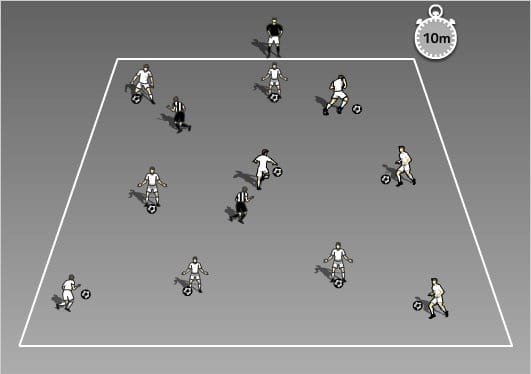
Time:Approximately 10 minutes.
Area: Approximately 15 x 15 yards (L x W) – the grid’s size depends on your numbers (how big/small you want to make it). Remember, making it bigger will make it easier for the dribblers. If you have large numbers, consider making two (or more) grids (and splitting by ability).
Activity: All players apart from the tagger(s) start with a ball and their task is to stay inside the grid and not get tagged by the tagger(s). Select a tagger or pair of taggers. Once a dribbler gets tagged, she must do 25 toe taps (or some other stationary skill that you want repeating), then stand with a foot on the ball and one hand in the air. She is then eligible to be “high-fived” back into the game by a dribbler. The objective for the taggers is to have all the dribblers standing with their hands in the air. Play the game as many times as is necessary to allow all the kids their turn at being a tagger (stop games that go on for longer than 30-45 seconds – or join in and help!). Give the tagger(s) a pinnie/bib!
Possible Progressions:
Change the number of toe taps/insides players have to do.
Instead of toe taps, have players do a certain number of ball juggles (e.g., 10 “feet only”).
Mandate that players can only use a certain foot (e.g., only left foot or only right foot) in the grid.
Add a tagger(s); make the grid bigger/smaller.
Activity #1: Introduction to The Gate Dribbling Game
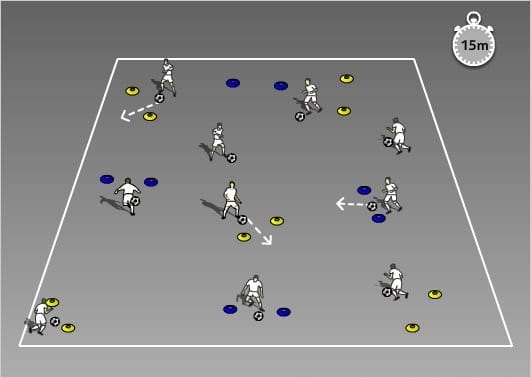
Time: Approximately 15 minutes.
Area: 25 x 25 yards (L x W) or larger depending on how many players you have.
Activity: Put players in pairs with a ball. Set up a number of 1.5-yard-wide gates randomly arranged in your grid. The size and number of gates can vary depending on the number of players you have and their skill level. I would start with at least as many gates as players. If you have a large group, create two grids, or have one group working while the other group rests. Players score a point for each gate they dribble the ball through. Go for 30-45 seconds and have each player keep count of how many points they score. See how many they get and ask how the top-scoring player got so many. Get them to do a quick demonstration. Repeat and see if players beat their original score. If your players are struggling with this game, make the gates bigger and/or change their locations. The objective is simply to get them dribbling in different directions with the ball under control. You should always start an activity by making it as simple as possible, so that players can quickly find success. Once they understand the game, that’s when you can start to make it progressively more challenging.
Possible Progressions:
Add a restriction whereby players can only dribble with their left foot (or right foot).
Add a restriction whereby players can only go through a gate using a certain surface (e.g., toe, laces, sole, etc.).
Replace some of the gates with pinnies (or different colored cones) and say that players must go through a cone gate followed by a pinnie gate (or different colored cone gate).
Make the gates smaller and/or reduce the number of gates.
Activity #2: The Gate Dribbling Game with Pressure
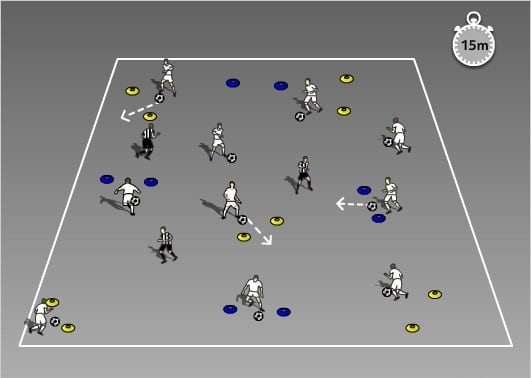
Time:Approximately 15 minutes.
Area:25 x 25 yards (L x W) or larger depending on how many players you have.
Activity:This activity is a progression from the previous one, which will allow you to give your players a quick water break and then get straight back into action. This time, start with a “bandit” whose job is to stop players from dribbling through the gates. Change the bandit every 30-45 seconds (get them to keep score of how many balls they kicked away).
Possible Progressions:
Add a restriction whereby players can only dribble with their left foot (or right foot).
Add another bandit (2 bandits at a time).
Replace some of the gates with pinnies (or different colored cones) and say that players must go through a cone gate followed by a pinnie gate (or different colored cone gate).
Add another bandit (3 bandits at a time).
Make the gates smaller and/or reduce the number of gates.
Add another bandit (4 bandits at a time).
Activity #3: Unbalanced Possession
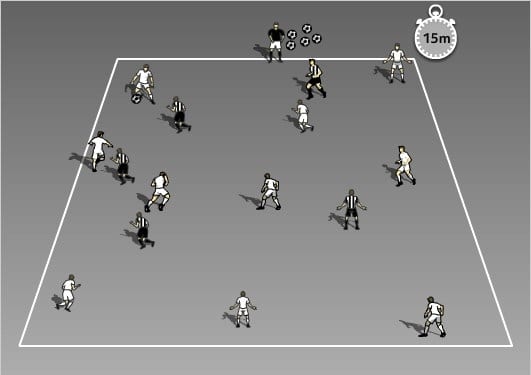
Time:Approximately 15 minutes
Area: 50 x 60 yards (W x L), or as close to half a game field as you can get. Start big, you can always make it smaller.
Activity: Split players up into two teams. One team should have a clear advantage in numbers (e.g. 8v4, 10v5, etc.), with that team’s objective being to keep the ball for as long as possible (a coach can keep count by counting the seconds out loud – I would suggest the first 5 are in your head!). Give players a certain amount of time (e.g., 3 minutes) and then take the highest number of consecutive seconds in possession from each team to declare a winner. Keep rotating the players, so they are not always on the chasing/possession team. If you have a large number of players (e.g., more than 20), you may want to consider using 2 smaller grids (in order to maximize the players’ number of touches and learning situations). If you have fewer players (e.g., 12 or less), you may want to make the field smaller.
Possible Progressions:
Make it so teams score a goal by keeping the ball for 10 seconds. Play first team to score 3 goals, wins.
Put the possession team on a touch restriction (e.g., 3 touch maximum, 2 touch maximum).
Add a halfway line and mandate that teams may only starting counting seconds in possession when the ball is in the opponents’ half.
End of Practice Scrimmage: Half Field Scrimmage with Gates
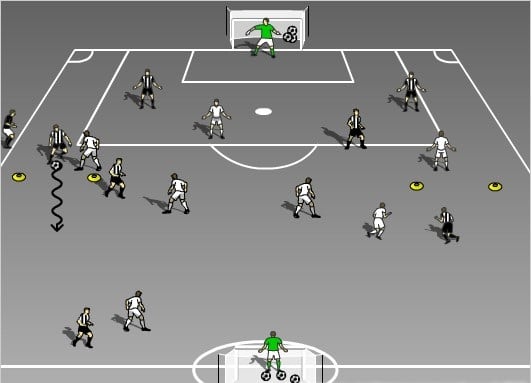
Time:Approximately 30 minutes (or whatever is left of practice).
Area: One half of the field. Add a gate (width of approximately 5 yards) on the halfway line on each flank (see diagram). By putting a Coerver goal on the halfway line, you can have two of these scrimmages at the same time. Depending on your numbers, you may want to play the entire width of the field or just the width of the 18-yard box. Typically, I will play the width of the 18 for 5v5 – 7v7; however, if you find that space too restrictive, you can always open it up.
Activity: Goals are scored in the usual way in the two big goals, but also by dribbling through one of the gates on either flank. This will encourage players to dribble the ball and look for the “open” gate, as well as the regular goal. Play even numbers and arrange teams in a formation that reflects your desired game day formation. For example, if you are playing 8v8, you can put teams in a 3-3-1 formation (this gives you central players as well as wide players on both defense and offense). Alternately, you can set up one (or both) of the teams in a 2-3-2 formation to change things up. This is a good game to play if you have the space and the numbers. If you don’t, no need to worry, just divide up the players into two even teams and let them play in the space you have available.
Progressions:
Add a gate in the middle of the field.
Have fixed goalkeepers, but play transition, so when one team scores in one goal, they immediately get the ball back and now go to the other goal (other team switches, too).
Take away the goalkeepers (will encourage players to take offensive risks).
Add a neutral(s) to give the team in possession an advantage.
Put one or both teams on touch restrictions (e.g., 3 touch max, 2 touch max, 1 touch max!).
*

